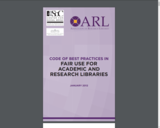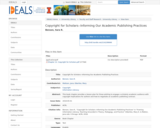
This PDF was found in the the SUNY OER Community Course files.
- Subject:
- Education
- Law
- Material Type:
- Reading
- Provider:
- State University of New York
- Date Added:
- 01/08/2024

This collection contains materials pertaining to copyright, fair use and fair dealing, open licensing, and related issues.

This PDF was found in the the SUNY OER Community Course files.

The aim of this toolkit is to support early career researchers in finding a journal that publishes their paper and optimally promotes the visibility of their research. How can they find a journal with a good journal ranking score that is perceived in the respective research community? How can they find a journal that perfectly matches their topic? Should they consider publishing open access? What are predatory journals and how can they detect them?

These materials are intended to be used both in graduate courses related to copyright or accessibility and by practitioners interested in learning more on the topic. Topics covered include the Chafee Amendment and how it has changed post-Marrakesh Treaty, the role of accessibility in the Authors Guild, Inc. v. HathiTrust decision, the importance of the Marrakesh Treaty for international efforts to make materials accessible across borders, and how licensing provisions can impact these various rights. The resources include videos explaining the key points of each topic, along with editable slide decks for those who wish to build on the existing materials, activities and options for assignments, recommended pre-class readings, discussion prompts, and related resources for those who want to learn more on the topics introduced in this OER module. There are also teaching notes for those interested in using the module in a class they are teaching.

This module takes a look at the advantages of OER and the Creative Commons for both instructors and their learners. Both instructors and learners can enjoy using OER as well as creating it for use by others!

This is a code of best practices in fair use devised specifically by and for the academic
and research library community. It enhances the ability of librarians to rely on fair
use by documenting the considered views of the library community about best
practices in fair use, drawn from the actual practices and experience of the library
community itself.

Information about how to determine whether a published work between 1923 and 1978 is in the public domain.

The Copyright Crash Course was created by Georgia Harper and is currently maintained by UT Libraries. The Course is arranged into several sections that allow users to explore certain areas of copyright law individually or as a group. The Course was originally created with faculty in mind, but can be used by anyone who is interested in understanding and managing their copyrights.

This lesson was created to introduce learners to Copyright law, the Fair Use Doctrine, and the Creative Commons.

Copyright Law: Cases and Materials is a free copyright law textbook designed for a four-credit copyright course, which is what we teach at NYU School of Law. Model syllabi for four-credit and three-credit courses are available in the Faculty Resources section of this website. All faculty teaching copyright law are welcome to access the Faculty Resources, including the faculty discussion forum, by becoming a registered user of the site. To register, write us at jeanne.fromer@nyu.edu or christopher.sprigman@nyu.edu.
The textbook is made available under a Creative Commons Attribution-NonCommercial-NoDerivatives 4.0 International License. Under the terms of this license, you are free to copy and redistribute the textbook in part or whole in any format provided that (1) you do so only for non-commercial purposes, and (2) you comply with the attribution principles of the license (credit the authors, and link to the license). Note please that this license does not permit you to make modifications to the textbook or to create derivative works. That said, there are a wide variety of derivatives that we would gladly permit. If you want to make modifications to the textbook, please contact us.

This chart is essential for anyone interested in knowing more about copyright laws in the United States. It provides term length based on date of creation, published or unpublished works, anonymous works, works made for hire, and more. It is well organized and provides a quick overview of the law as it has changed over the years in the United States.

The Copyright X Course is taught by professors at Harvard University and is available synchronously to a limited number of librarians each year. However, the entire course content is available online and is openly licensed. This is a more traditional course on copyright and includes topics that would largely be discussed in a law classroom, such as theories underlying copyright law, cultural theory as it applies to copyright, and secondary liability for copyright. The course also covers many traditional areas of copyright, though, including basic foundations of copyright law, the different rights included with copyright (such as the right to reproduction, distribution and performance), and, of course, fair use. Included in the course are video lectures and lecture slides.

This is a full length monograph aimed at helping libraries, archives, and museums navigate copyright law involving digitization. In the course of the book, though, the authors helpfully unpack many areas of copyright law including Section 108 of the Copyright Act, Fair Use, Licensing, and Risk Management. It is a great primer on copyright law and includes many helpful key points, flowcharts and timelines.

This webinar complete with slides, a video, and an extra resources/Q&A briefing at the end is a wonderful place to start if you've never studied copyright before. It could accompany some basic copyright readings, or be used as a copyright primer on its own. It is geared towards a library science audience and is a straightforward introduction to copyright formation, fair use, basic licensing, and Creative Commons licensing.

This open education online course is designed for librarians to gain a basic understanding in copyright, international copyright issues, licensing, and it even contains a module on traditional knowledge and activism.
The modules on activism and traditional knowledge make this resource a bit unique and useful as an add-on to any "traditional" copyright training modules.

This is a full length textbook explaining copyright for librarians. It has a particularly helpful chapter explaining international treaties and the Berne three-step test. The chapter on "creative approaches and alternatives" has a helpful introduction to the Creative Commons as well as Open Access.
It also has helpful case study examples to demonstrate the concepts in an applied manner which really will help students to better understand the content of the textbook.

This book chapter provides a lesson plan for those wishing to engage a scholarly academic audience with copyright implications for authors and how to negotiate an academic publishing contract. It is an interactive "game" where students play either the author or the publisher and negotiate copyright, open access, and article publication fees.

This open access book is tailored to educators and librarians to teach them more about how to use and apply creative commons licenses. The book covers the basics of copyright law and licensing, as well as how to choose, find, and use creative commons licensed materials. There is an entire section of the book specifically dedicated to creative commons for educators and librarians, including chapters on open access to scholarship, open pedagogy, open educational resources, and more.

The ETD+ Virtual Workshop Series, taught by Dr. Katherine Skinner, is a set of free introductory training resources on crucial data curation and digital longevity techniques. Focusing on the Electronic Thesis and Dissertation (ETD) as a mile-marker in a student’s research trajectory, it provides in-time advice to students and faculty about avoiding common digital loss scenarios for the ETD and all of its affiliated files.
About the ETDplus Project
The ETDplus project is helping institutions ensure the longevity and availability of ETD research data and complex digital objects (e.g., software, multimedia files) that comprise an integral component of student theses and dissertations. The project was generously funded by the Institute of Museum and Library Services (IMLS) and led by the Educopia Institute, in collaboration with the NDLTD, HBCU Alliance, bepress, ProQuest, and the libraries of Carnegie Mellon, Colorado State, Indiana State, Morehouse, Oregon State, Penn State, Purdue, University of Louisville, University of Tennessee, the University of North Texas, and Virginia Tech.
Acknowledgements
This project was made possible in part by the Institute of Museum and Library Services.

List of exercises, presentation slides, and poster on research data management and scholarly communication topics by Chealsye Bowley.

This is a video about Fair Use Rights created by Sara Benson, copyright librarian at the University of Illinois Library. This brief video explains fair use, risk assessment, and some key fair use cases.